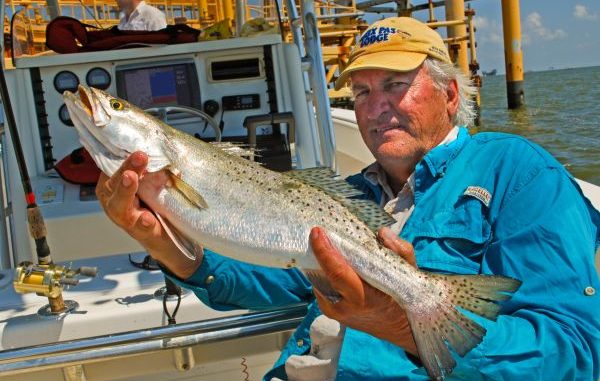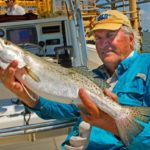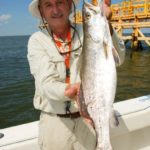
Forget hard-fighting reds. There’s only one fish this team of Venice anglers crave only one species — big, burly speckled trout. Here’s how they go target the bruisers, with hopes of winning the STAR.
He’s got it. He’s got it bad!
Tony Bruce has spotted fever — a burning desire to put big spotted seatrout in the boat.
The sine qua non of his fishing existence is to win the 100-day long Coastal Conservation Association STAR.
Sure, you win a fully rigged fishing boat, but more importantly you gain entry into a select club of Louisiana trophy trout fishermen.
He has just missed several times. With grim humor, he calls himself “always a bridesmaid.”
Bruce is good-natured, but it’s easy to see that it rankles him.
Tony Bruce is a tall, craggy man with features that look like they were chiseled from granite.
He had assembled his regular fishing team for this Venice run. Senior man on the team was his slender, silver-mustached older brother Charlie.
He owns the 34-foot Venture from which they were fishing, and he was in charge of the live bait-trawling end of the operation.
“I spent quite a bit of time on my father’s shrimp boat,” he explained.
Charlie is not quite as speckled trout-crazy as Tony. He splits his fishing time between big speckled trout and offshore fishing.
He loves red snappers.
The third man on the team was 57-year-old Craig Hunt, a friend and business associate of Tony’s. The experienced trophy trout fisherman is of medium build with curly hair, a grizzled beard and glasses.
Hunt began fishing in Venice more than 25 years ago, long before Tony.
“When I was young, we used to make ‘Kamikaze trips’ to Venice,” Hunt said. “We would leave Zachary at 3 a.m., fish all day for trout, redfish, bass and flounder, clean the fish after dark and then get home at 11 p.m.”
The thought now makes him shake his head.
“I got old and don’t do that anymore,” Hunt said “Now I focus on big trout.”
Rounding out the gang was Tony’s 32-year-old son Chris. He is a younger, even taller version of his father. A prominent chin gives away his fierce determination to catch big speckled trout.
Well before daylight, Charlie took the boat out Baptiste Collette Bayou to the northeastern side of the Mississippi River delta. Once outside, Tony took over the wheel while Charlie set the trawl in the dark.
Two short drags produced all the live bait they needed to start the day.
Although they would trawl again later in the day for fresh bait, they said drags made before sunup are always the most productive.
Surprisingly, they stored their shrimp and croakers together in the same livewell.
All their fishing on this day would be at rigs: small, medium, and large platforms fringing the Mississippi River delta in the magic depth range of 16 to 25 feet.
They don’t fish interior marshes at all and they don’t fish beaches anymore.
Besides rigs, their only other fishing targets are the mouths of major passes.
Between 90 and 100 rigs lie in the magic depth zone arching around the mouth of the Mississippi River from off Baptiste Collette around to West Delta.
The rigs fall into four general areas.
The Breton Sound area has four or five rigs. The Main Pass area between Baptiste Collette and Lonesome Bayou has 30 rigs. The South Pass area from Pass a Loutre to East Bay has another dozen, and West Delta from East Bay to Southwest Pass has about 50 rigs.
The men have narrowed their targets down to about favorite 20 rigs through trial and error.
“Some are better than others,” Tony said.
They idled up to their first platform, and Chris clambered up on the bow to hook up the boat.
“I caught a 7-13 here,” Tony said.
Everybody immediately hooked up — all redfish.
“Big fish are slow to reel in,” Chris groaned. “I hate redfish.”
The number of redfish didn’t disturb Tony, though.
“Sometimes we are catching redfish one after the other. Then all of a sudden, the trout will turn on and we will catch nothing but trout,” he said.
Still, after eight or nine redfish, Tony was done.
“We’re going to have to make a major move,” he announced.
Throughout the course of the day, the men paid great care to get what Tony called a “quality anchor set,” something he described as second only to having live bait available.
Typically, on the first approach to a rig, they use a rig hook to keep the bow of the boat pointed into the current.
If that position doesn’t produce fish, they make a couple of anchor sets directly or diagonally upcurrent from the rig and cast toward the rig, attempting to place their bait as close to the rig as possible.
At some rigs, they positioned the boat so close to the rig that their rod tips were inside the structure.
They used previous experiences with a particular rig to guide them in their approach.
The next rig was one of a group of platforms south of their first stop. As they pulled up, it was easy to see that the water was quite dingy from river discharge.
“Don’t worry about the dirty water on top,” Tony said. “There’s clear water beneath.”
One redfish later, they moved the boat 30 feet and rehooked it to the rig.
Chris, Tony and Charlie each caught big sheepshead, plus Charlie caught and kept a medium-sized redfish.
The sheepshead were gladly kept, but in spite of Charlie keeping his redfish it was very clear the crew held redfish in utter contempt.
Chris regularly groused about having to reel them in.
“Don’t take my picture with that,” Chris groused at me when he saw me pick up my camera for a redfish.
He went so far as to hold the fish below the rail of the boat to unhook and release it so it couldn’t be photographed.
They moved the boat diagonally upcurrent. The move produced no fish of any kind.
So it was off to the next rig in the arc of rigs around the delta. By 8:30 a.m. and three rigs later, they had nothing to show for their efforts but a bunch of redfish and sheepshead.
They made yet another move.
“The strategy,” Tony explained, “is to move, move, move until you get on them. Then you stay on them as long as you can.”
The thumping hum of a rig’s compressors prompted a comment from him.
“I have a theory that platforms with compressors attract trout,’ Tony said. “They sound like croakers, and everybody knows that trout hate croakers.
“I don’t know if it is true or not.”
Finally, at 9:30 a.m. — at the sixth rig — Charlie scored on the first speckled trout of the day, and the race was on.
Everyone caught fish. They were catching the trout in a huge trash pile set off a bank of yellow headers coming off the rig.
“It’s like a spaghetti down there, but it really holds bait,” Tony said with a grin.
The medium-heavy tackle the men used helped them pressure the fish hard to quickly get them away from the maze of line-snapping trash.
Several times, they had to simply hold steady pressure on hooked trout that were tangled to let them swim out of the entanglement.
The majority of specks were 2 pounds and up. Bragging fish for most anglers.
But the really big one — the STAR winner — wasn’t there that day.
By 11 a.m., with the box bulging with speckled trout, Tony decided to humor Charlie with a quick run to a rig in 69 feet of water for a state limit of red snappers.
Charlie had been subtly hinting to his brother all morning that some red snappers with the specks would be nice. And the quick limit left him purring like a contented cat in his bean bag chair for the ride in.
When the boat entered the Mississippi River on the way back to Cypress Cove Marina, the quartet began loudly debating their options for the next day.
From my perch in the bow, I could clearly hear Tony’s voice booming.
“We can catch a STAR trout tomorrow if ….”


